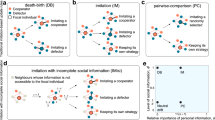Abstract
The theory of imitative behavior, developed previously, is applied to the case of two social groups which are separated spatially. If the information of each group as to the behavior of the other is complete, the case reduces to that of a single group. When any information is lacking at all, the two groups are independent. If we have two mutually exclusive behaviorsA andB, all four combinationsAA, AB, BA, andBB are possible. If the mutual information gradually increases from zero, then for a certain value of it, the group which is more informed about the behavior of the other will change to that behavior if it did not already exhibit it. If for constant information the size of the group increases, then above a certain threshold value, the larger group imposes its behavior on the smaller.
Similar content being viewed by others
Literature
Rashevsky, N. 1949a. “Mathematical Biology of Social Behavior: II”.Bull. Math. Biophysics,11, 157–63.
— 1949b. “Mathematical Biology of Social Behavior: III”.Ibid.,11, 255–71.
— 1950. “Mathematical Biology of Social Behavior: IV. Imitation Effects as a Function of Distance”.Ibid.,12, 177–85.
— 1951a.Mathematical Biology of Social Behavior. Chicago: University of Chicago Press.
— 1951b. “A Note on Imitative Behavior and Information”.Bull. Math. Biophysics,13, 147–51.
Author information
Authors and Affiliations
Rights and permissions
About this article
Cite this article
Rashevsky, N. Imitative behavior in nonuniformly spatially distributed populations. Bulletin of Mathematical Biophysics 15, 63–71 (1953). https://doi.org/10.1007/BF02476368
Issue Date:
DOI: https://doi.org/10.1007/BF02476368




